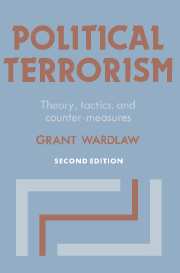Book contents
- Frontmatter
- Contents
- Preface to the second edition
- Preface to the first edition
- Part One An introduction to political terrorism
- 1 The problem of defining terrorism
- 2 Terrorism: a historical perspective
- 3 The changing nature of terrorism
- 4 The purpose of terrorism
- 5 The development of terrorism as a strategy
- 6 Trends in terrorism
- 7 The effects of terrorism
- Part Two Some selected problems in the response to terrorism
- Notes
- Select bibliography
- Index
1 - The problem of defining terrorism
Published online by Cambridge University Press: 05 January 2012
- Frontmatter
- Contents
- Preface to the second edition
- Preface to the first edition
- Part One An introduction to political terrorism
- 1 The problem of defining terrorism
- 2 Terrorism: a historical perspective
- 3 The changing nature of terrorism
- 4 The purpose of terrorism
- 5 The development of terrorism as a strategy
- 6 Trends in terrorism
- 7 The effects of terrorism
- Part Two Some selected problems in the response to terrorism
- Notes
- Select bibliography
- Index
Summary
Groups with little or no direct political power have demonstrated repeatedly in recent years that by employing certain tactics, central to which is the use of directed terror, they can achieve effects on a target community which are out of all proportion to their numerical or political power. Such tactics attract worldwide publicity, create widespread panic or apprehension and cause national governments to concede to the demands of small subgroups within society. These effects in themselves Create a demand for an understanding of the use of terror for political ends. In attempting such an undertaking it is desirable first to ascertain the substance of the threat – to separate the reality from the media image, to ascertain whether current terrorism is an outgrowth of past uses of terror or a unique phenomenon generated by new political forces. In addition to understanding its genesis and contemporary motivation there is a need to assess whether new developments such as transportation, communication, and weaponry give the use of terror more leverage than past forms of terror and therefore result in a greater threat than in the past.
The first analytical task facing commentators on terror is to define their subject matter. Because terrorism engenders such extreme emotions, partly as a reaction to the horrors associated with it and partly because of its ideological context, the search for a definition which is both precise enough to provide a meaningful analytical device yet general enough to obtain agreement from all participants in the debate is fraught with difficulty.
- Type
- Chapter
- Information
- Political TerrorismTheory, Tactics and Counter-Measures, pp. 3 - 17Publisher: Cambridge University PressPrint publication year: 1989



